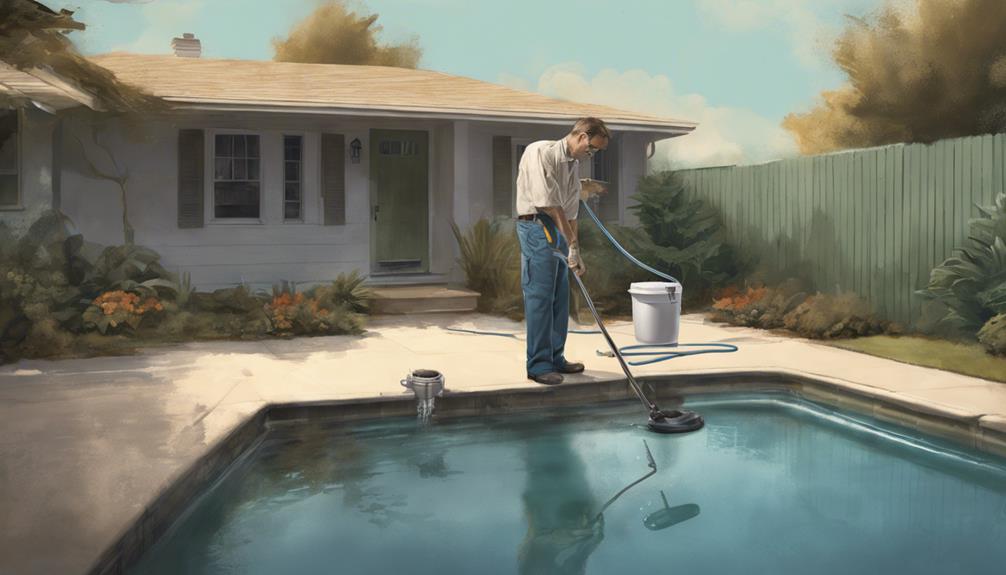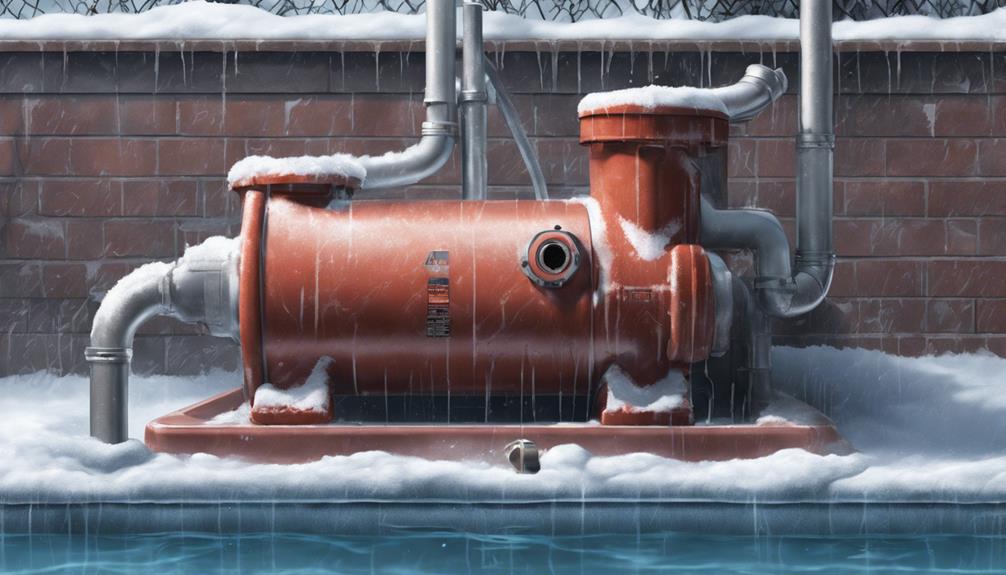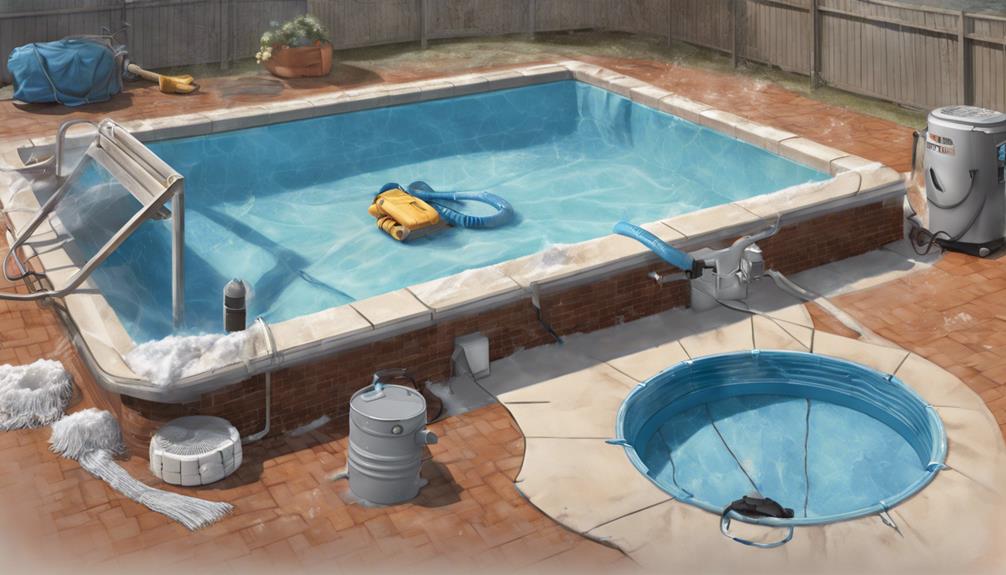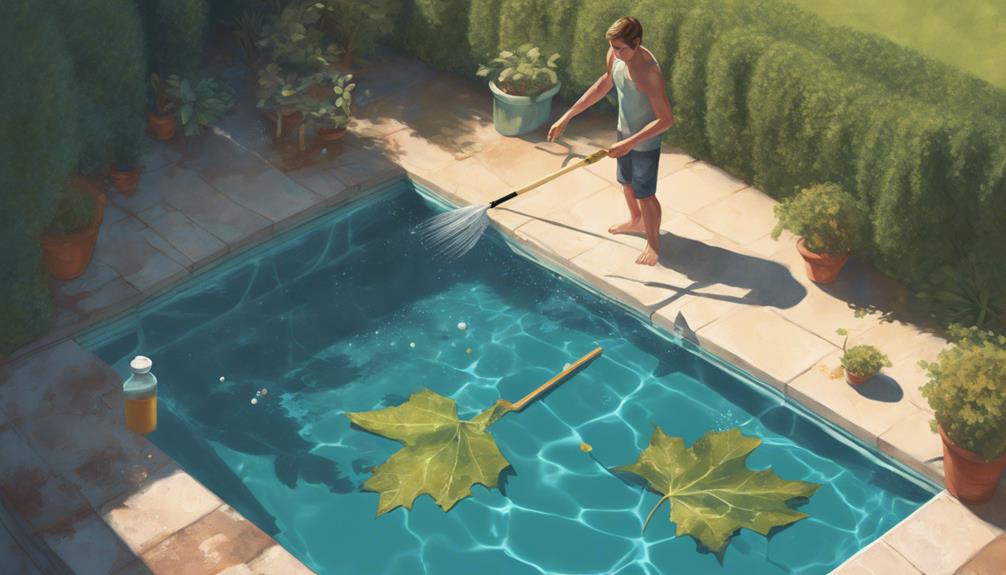Make sure your pool is securely closed as temperatures start to drop below freezing. Purchase a high-quality pool cover and make sure it stays clean to prevent debris and damage. Keep the water levels correct by draining it to just below the skimmer. Test and balance the chemical levels on a weekly basis to avoid any problems and ensure a smooth opening in the spring. Prevent frozen pipes by emptying out the equipment and keeping an eye on the temperatures. Take the necessary steps to protect your pool this winter with expert tips and techniques.
Key Takeaways
- Thoroughly close your pool to protect it from winter damage.
- Use a quality cover and secure it properly.
- Drain water to the recommended level to prevent damage.
- Maintain proper chemical balance for water quality.
- Prevent frozen pool pipes by draining equipment and monitoring temperatures.
Closing Your Pool Properly
Prepare your pool for the winter season by ensuring a thorough and proper closure process. As temperatures drop, it is essential to shut off pool equipment when nights reach below 30°F to prevent damage.
Refer to product manuals for specific instructions on caring for submerged items during winter. By following manufacturer guidelines, you can protect your pool investment and guarantee a smooth opening next season.
Properly closing your pool involves more than just covering it; it includes draining water to the appropriate level, balancing chemical levels, and preventing frozen pipes. By taking these steps, you can safeguard your pool against winter damage and simplify the reopening process come springtime.
Covering Your Pool Adequately
As winter approaches, safeguarding your pool is vital to shield it from debris, rainwater, snow, and ice. Investing in a quality pool cover, preferably automatic, is essential to prevent these elements from entering the pool during the off-season. A securely fitting cover is necessary to prevent slipping and guarantee maximum protection.
Regularly cleaning off the cover throughout the winter will save time and effort when reopening the pool. Additionally, securing the cover with anchors or weighted objects will help keep it in place and maintain its effectiveness.
Properly covering your pool will not only protect it from environmental factors but also contribute to a smoother pool opening process in the spring.
Draining Pool Water Safely

To safeguard your pool from potential damage during winter, proper drainage of pool water is vital. While evaporation is common during summer, freezing water can lead to costly repairs if not managed correctly.
It is recommended to drain the water to a level 4-6 inches below the skimmer to prevent freezing. In warmer climates, maintaining the water level almost to the top is advisable. By managing water levels effectively, you can protect the pool finish and prevent structural damage.
Remember that maintaining proper water levels is essential for the overall health and longevity of your pool. Proper drainage is a key step in winterizing your pool and ensuring a smooth reopening in the next season.
Balancing Chemical Levels Effectively
Maintaining proper chemical balance in your pool is essential for guaranteeing water quality and preventing common pool issues.
Testing the water weekly to monitor pH and chlorine levels is vital. While chlorine may not need to be added during the winter when the pool is inactive, it's important to keep the chemical balance stable to prevent issues like cloudy water, algae growth, or filtration problems.
Imbalances can lead to costly repairs and impact the overall cleanliness of the pool. By staying on top of the chemical levels and making adjustments as necessary, you can ensure a smooth reopening process and enjoy a clean and safe pool when the warmer weather returns.
Preventing Frozen Pool Pipes

Preventing frozen pool pipes is fundamental for safeguarding your pool equipment during the winter season. To prevent damage, drain water from the pump, heater, and filter to avoid cracking.
Check for visible cracks or loose tiles around the pool that may indicate vulnerabilities to freezing temperatures. Remove and drain plugs from the pool equipment to prepare them for winter conditions.
Opening valves to allow water to move through the pipes can also help prevent freezing. Monitoring temperatures regularly is vital to catching any issues before they lead to expensive repairs.
Taking these preventive measures will help guarantee that your pool equipment remains intact and functional throughout the winter months.
Frequently Asked Questions
How Often Should I Check on My Pool During the Winter?
During winter, check your pool at least once a week to monitor chemical levels, water clarity, and any signs of freezing. Regular inspections guarantee a well-maintained pool and prevent costly repairs when reopening in the spring.
Can I Use a Regular Tarp Instead of a Pool Cover?
Attempting to substitute a regular tarp for a pool cover is akin to comparing apples and oranges—both serve different purposes. A quality pool cover, not a mere tarp, shields against debris, rain, snow, and ice, ensuring best pool protection.
Is It Necessary to Add Algaecide Before Closing the Pool?
Adding algaecide before closing the pool is not necessary but recommended. Algaecide can help prevent algae growth during the winter months. Properly balancing chemical levels, covering the pool, and maintaining water levels are essential for winter pool care.
Should I Remove the Pool Ladder Before Winterizing?
Yes, it is advisable to remove the pool ladder before winterizing. This prevents damage due to freezing temperatures and reduces wear on the ladder. Store the ladder in a dry, covered area to guarantee it remains in good condition for the next swimming season.
Can I Use Pool Antifreeze to Prevent Freezing Pipes?
To prevent freezing pipes in your pool during winter, using pool antifreeze is a recommended practice. This solution helps safeguard your pool equipment from damage caused by frigid temperatures, ensuring a smooth shift into the next season.
How Can I Prepare My Pool for Winter and Extend its Use into Autumn?
Preparing your pool for winter and extending its use into autumn is essential for maximizing enjoyment. Clean and cover the pool to prevent debris buildup and damage from freezing temperatures. Consider investing in a pool heater to extend the swimming season and dive into autumn delights for longer.
What Is the Best Way to Winterize Your Pool Like a Pro and Ensure Perfect Timing?
Winter pool timing matters when it comes to winterizing your pool like a pro. The best way to ensure perfect timing is by starting the winterization process before the temperature drops below 65 degrees Fahrenheit. This will allow you to properly clean, balance chemicals, and cover your pool before the harsh winter conditions set in.
Conclusion
To sum up, winterizing your pool like a professional is essential for protecting your investment and ensuring a smooth reopening in the spring.
While the process may seem challenging, following these steps will save you time and money in the long run.
One anticipated objection may be the perceived complexity of winterizing a pool, but with proper guidance and planning, you can successfully maintain your pool throughout the winter months.










